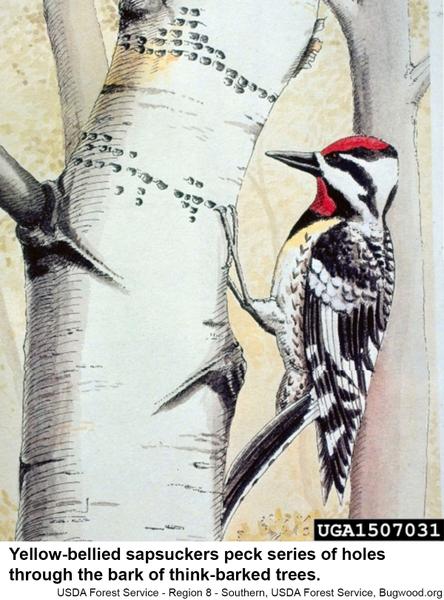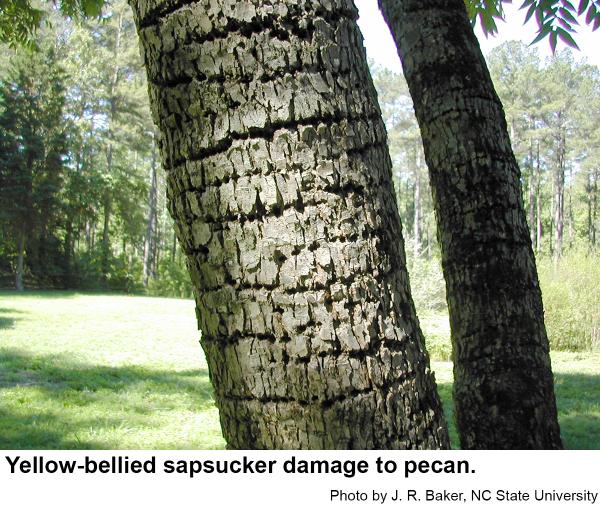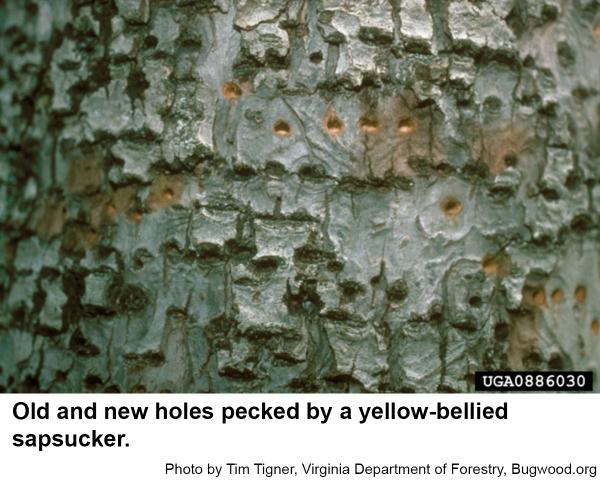Description and Biology
The yellow-bellied sapsucker, Sphyrapicus varius, is the only member of the woodpecker family that pecks series of horizontal ¼ inch holes in the bark of trees. These birds have a black crescent on the breast, pale yellow belly, white wing stripe, and a crimson crown. Males have crimson chins and throats; females have white chins and throats. Although insects make up part of its diet, the sapsucker is better known for its pecking of numerous holes in the bark of live trees to sip sap using its brush-like tongue. Sapsuckers in search of nesting sites are especially attracted to trees infected with heart rot fungi, which decays the heartwood and enables the birds to excavate a nest hole. In early spring sapsuckers may test many trees around its selected nesting site by pecking sample holes before selecting ones it prefers. These trees, because of quantity or sugar content of the sap, are visited several times a day for the rest of the season and are sometimes are used as a food source for several years.
Host Plants
More than 250 species of woody plants are known to be attacked. Pecan, maple, and hemlock are preferred species although Scots pine, elm, and apple are readily used as well. The sapsucker pecks neat rows of 1/4-inch holes spaced closely together through the bark of trees along and around portions of the limbs or trunk. The holes are periodically enlarged and portions of the cambium and inner bark, together with the fresh sap, are eaten. Puncture wounds and resulting sap flow on branches and trunks of trees are the most obvious symptoms of injury inflicted by the sapsucker.
Residential Recommendations
To discourage sapsuckers from feeding on a favorite shade tree, wrap hardware cloth or burlap around the area being attacked. The Migratory Bird Treaty Act and Federal regulations prohibit shooting of sapsuckers. Although tempting, shooting yellow-bellied sapsuckers would only provide temporary relief anyway as transient birds would soon replace the dead birds.
References
- How to Identify and control sapsucker injury on trees. Ostry, M. E., T. H. Nicholls, and W. R. Jones. 1978. North Central Forest Experiment Station, Forest Service, USDA
- Yellow-bellied Sapsucker, Sphyrapicus varius (L.), Red-naped Sapsucker, Sphyrapicus nuchalis Baird, Williamson's Sapsucker, Sphyrapicus thyroideus Cassin. Bush, B. (modifier), R. Koski et al. 2016. High Plains IPM.
- Extension Plant Pathology Publications and Factsheets
- Horticultural Science Publications
For assistance with a specific problem, contact your local N.C. Cooperative Extension Center.
This Factsheet has not been peer reviewed.
Publication date: June 8, 2016
Reviewed/Revised: Oct. 28, 2019
N.C. Cooperative Extension prohibits discrimination and harassment regardless of age, color, disability, family and marital status, gender identity, national origin, political beliefs, race, religion, sex (including pregnancy), sexual orientation and veteran status.



